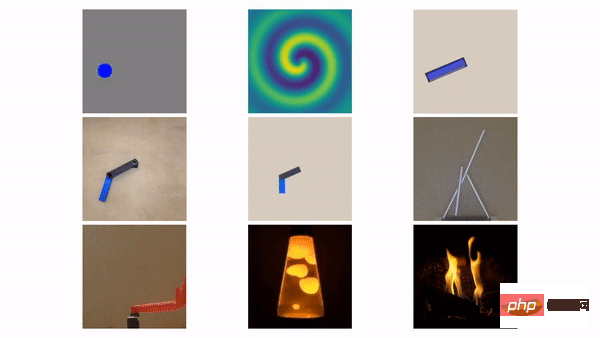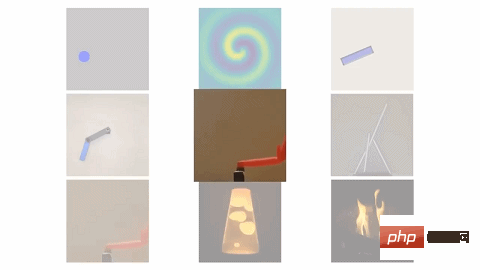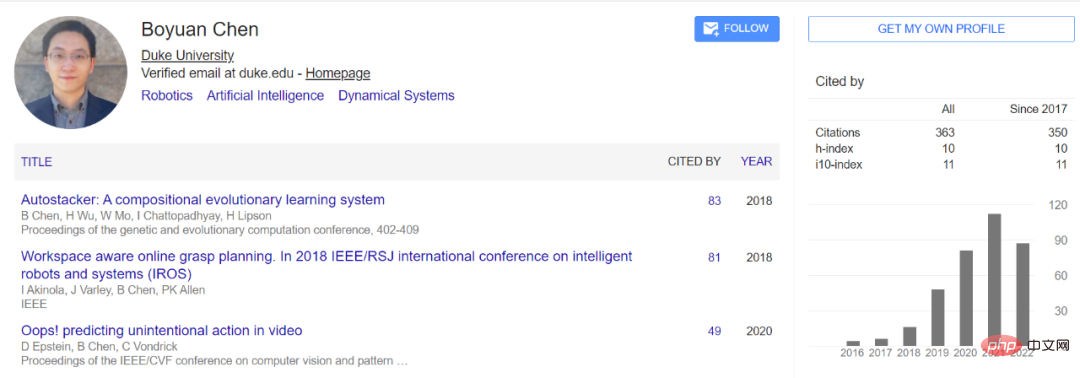 Technology peripherals
Technology peripherals
 AI
AI
 Besides angular velocity and linear velocity, is there another way to describe the universe? AI discovers new variables published in Nature sub-journal
Besides angular velocity and linear velocity, is there another way to describe the universe? AI discovers new variables published in Nature sub-journal
Besides angular velocity and linear velocity, is there another way to describe the universe? AI discovers new variables published in Nature sub-journal
Letting AI discover physical laws is nothing new. Some time ago, we reported the news that "give GNN a bunch of data, and it can discover the law of gravity by itself." But what if we don't even give it variables? A study from Columbia University shows that AI can extract variables on its own just by observing phenomena through a camera, and some of them may not be discovered by humans yet. If we use this method to discover new variables, can we discover new physical laws?
E = mc² is a mass-energy equation that explains the relationship between energy and mass, where E represents energy, m represents mass, and c represents the speed of light (constant, c=299792458m/s, sometimes taken 3.00×108 m/s). The mass-energy equation was proposed by Einstein. It is mainly used to explain the mass loss in nuclear reactions and to calculate the energy of particles in high-energy physics. It also contributed to the birth of wave mechanics.
More than a hundred years ago, Einstein obviously had the basic variables of energy, mass and speed before proposing this equation. Without these variables, even Einstein would not have been able to discover the theory of relativity. But surprisingly, artificial intelligence can now automatically discover these variables, some of which are beyond the scope of human knowledge, which will greatly speed up scientific discovery.
This is a new study from Columbia University. Researchers tried to let an artificial intelligence program observe physical phenomena through cameras, and then tried to search for the smallest basic variables that can fully describe the observed phenomena. set. The research paper was published July 25 in the journal Nature Computational Science.

##Paper address: https://www.nature.com/articles/s43588-022-00281-6
As shown in the figure below, this research allows AI to observe videos of moving chaotic joystick-driven systems, and identify and extract from these high-dimensional video clips the minimum states required to describe such systems. variable.

The scientists first fed the system raw video clips of physical phenomena for which they already knew the solution. For example, they provided a video of a swinging pendulum, which is known to have four "state variables"—the angle and angular velocity of each of its two arms. After several hours of analysis, the AI outputted the answer: 4.7.
"We think this answer is close enough," said Hod Lipson, co-author of the paper and director of the Creative Machines Lab in the Department of Mechanical Engineering. "Especially considering that all the AI has access to is raw video footage, without any knowledge of physics or geometry. But we want to know what variables it uses, not just a number."
The researchers then went on to visualize the actual variables identified by the AI program. Extracting the variables itself is difficult because the program cannot describe them in any intuitive way that humans can understand. After some investigation, two variables selected by the program seemed to roughly correspond to the angles of the two swing arms, but the other two remained a mystery.
"We try to relate the other two variables to all the known variables we can think of: angular and linear velocities, kinetic and potential energy, and various combinations of known quantities, ” explained Boyuan Chen, the first author of the paper and now an assistant professor at Duke University who just received his PhD from Columbia University. “But none of the known variables seemed to perfectly match the two variables identified by the AI program.” The team believes the AI has found a valid set of four variables because it made a good prediction, "but we don't yet understand the mathematical language it uses," he explains.
After verifying many other physical systems with known solutions, the scientists entered videos of systems for which they did not know a clear answer. One of the videos shows a balloon swaying in the wind. After several hours of analysis, the program returned 8 variables. Likewise, videos about lava lamps yielded 8 variables. When the video was changed to a video about a fireplace, the program returned 24 variables.

A particularly interesting question is: Is the set of variables found by the AI program unique for each system? In other words, after each restart of the program, will the next set of variables it finds still be the same as the original one?
"I have been thinking, if we could meet a particularly intelligent alien species, would they have also discovered some of the physical laws we have discovered? Or, would they Will the universe be described in a different way?" Lipson said. "Perhaps some phenomena seem very complicated because we have been trying to describe them with the wrong set of variables."
In the experiment, the number of variables extracted by AI is the same every time it is restarted, but the specific variables each time are different. Therefore, we do have other ways to describe the universe besides the conventional way, and the way we choose now may not be perfect.
Researchers say that this kind of AI can help scientists discover complex phenomena in biology, cosmology and other disciplines, in which theoretical understanding cannot keep up with the massive amounts of data. pace of. "Although we used video data in this work, any type of array data source can be used - such as a radar array or a DNA array," explains co-author Kuang Huang.
This work is part of a decades-long research interest by Lipson and Qiang Du, Fu Foundation Professor of Applied Mathematics at Columbia University, to create ways to create data that can be Algorithms refined into scientific laws. Past software systems, such as Lipson and Michael Schmidt's Eureqa software, could extract arbitrary physical laws from experimental data, but only if the variables were predetermined. But what if we don’t even know the variables yet?
Lipson believes that scientists sometimes misunderstand or fail to understand a phenomenon simply because they don't have a good set of variables to describe it. "For thousands of years, people have had the concept of how fast an object is moving, but it was not until the concepts of speed and acceleration were formally quantified that Newton discovered Newton's famous second law: F=MA," Lipson said. These variables are the preconditions for the theory to be formed. Based on this, Du Qiang wanted to know, "What other laws have not been discovered by us because of the lack of variables?"
Author Introduction
The first author of the paper, Chen Boyuan, is currently an assistant professor at Duke University and is responsible for leading the General Robotics Lab. He graduated with a Ph.D. in computer science from Columbia University, majoring in computer vision, machine learning and robotics. He studied under Professor Hod Lipson, a world pioneer in robotics, data science and 3D printing. He has published many papers at top international conferences in the field of artificial intelligence and robotics (NeurIPS, IROS, GECCO, Humanoids, etc.) and served as a reviewer for multiple international conferences (CVPR, ICML, ICLR, PRCV, etc.). In addition, he has also received ACM GECCO Student Scholarship, Chinese Government Scholarship, Chinese Academy of Sciences Space Science and Technology Innovation Scholarship, etc.

The above is the detailed content of Besides angular velocity and linear velocity, is there another way to describe the universe? AI discovers new variables published in Nature sub-journal. For more information, please follow other related articles on the PHP Chinese website!

Hot AI Tools

Undresser.AI Undress
AI-powered app for creating realistic nude photos

AI Clothes Remover
Online AI tool for removing clothes from photos.

Undress AI Tool
Undress images for free

Clothoff.io
AI clothes remover

AI Hentai Generator
Generate AI Hentai for free.

Hot Article

Hot Tools

Notepad++7.3.1
Easy-to-use and free code editor

SublimeText3 Chinese version
Chinese version, very easy to use

Zend Studio 13.0.1
Powerful PHP integrated development environment

Dreamweaver CS6
Visual web development tools

SublimeText3 Mac version
God-level code editing software (SublimeText3)

Hot Topics
 1385
1385
 52
52
 Centos shutdown command line
Apr 14, 2025 pm 09:12 PM
Centos shutdown command line
Apr 14, 2025 pm 09:12 PM
The CentOS shutdown command is shutdown, and the syntax is shutdown [Options] Time [Information]. Options include: -h Stop the system immediately; -P Turn off the power after shutdown; -r restart; -t Waiting time. Times can be specified as immediate (now), minutes ( minutes), or a specific time (hh:mm). Added information can be displayed in system messages.
 How to check CentOS HDFS configuration
Apr 14, 2025 pm 07:21 PM
How to check CentOS HDFS configuration
Apr 14, 2025 pm 07:21 PM
Complete Guide to Checking HDFS Configuration in CentOS Systems This article will guide you how to effectively check the configuration and running status of HDFS on CentOS systems. The following steps will help you fully understand the setup and operation of HDFS. Verify Hadoop environment variable: First, make sure the Hadoop environment variable is set correctly. In the terminal, execute the following command to verify that Hadoop is installed and configured correctly: hadoopversion Check HDFS configuration file: The core configuration file of HDFS is located in the /etc/hadoop/conf/ directory, where core-site.xml and hdfs-site.xml are crucial. use
 What are the backup methods for GitLab on CentOS
Apr 14, 2025 pm 05:33 PM
What are the backup methods for GitLab on CentOS
Apr 14, 2025 pm 05:33 PM
Backup and Recovery Policy of GitLab under CentOS System In order to ensure data security and recoverability, GitLab on CentOS provides a variety of backup methods. This article will introduce several common backup methods, configuration parameters and recovery processes in detail to help you establish a complete GitLab backup and recovery strategy. 1. Manual backup Use the gitlab-rakegitlab:backup:create command to execute manual backup. This command backs up key information such as GitLab repository, database, users, user groups, keys, and permissions. The default backup file is stored in the /var/opt/gitlab/backups directory. You can modify /etc/gitlab
 Detailed explanation of docker principle
Apr 14, 2025 pm 11:57 PM
Detailed explanation of docker principle
Apr 14, 2025 pm 11:57 PM
Docker uses Linux kernel features to provide an efficient and isolated application running environment. Its working principle is as follows: 1. The mirror is used as a read-only template, which contains everything you need to run the application; 2. The Union File System (UnionFS) stacks multiple file systems, only storing the differences, saving space and speeding up; 3. The daemon manages the mirrors and containers, and the client uses them for interaction; 4. Namespaces and cgroups implement container isolation and resource limitations; 5. Multiple network modes support container interconnection. Only by understanding these core concepts can you better utilize Docker.
 How is the GPU support for PyTorch on CentOS
Apr 14, 2025 pm 06:48 PM
How is the GPU support for PyTorch on CentOS
Apr 14, 2025 pm 06:48 PM
Enable PyTorch GPU acceleration on CentOS system requires the installation of CUDA, cuDNN and GPU versions of PyTorch. The following steps will guide you through the process: CUDA and cuDNN installation determine CUDA version compatibility: Use the nvidia-smi command to view the CUDA version supported by your NVIDIA graphics card. For example, your MX450 graphics card may support CUDA11.1 or higher. Download and install CUDAToolkit: Visit the official website of NVIDIACUDAToolkit and download and install the corresponding version according to the highest CUDA version supported by your graphics card. Install cuDNN library:
 Centos install mysql
Apr 14, 2025 pm 08:09 PM
Centos install mysql
Apr 14, 2025 pm 08:09 PM
Installing MySQL on CentOS involves the following steps: Adding the appropriate MySQL yum source. Execute the yum install mysql-server command to install the MySQL server. Use the mysql_secure_installation command to make security settings, such as setting the root user password. Customize the MySQL configuration file as needed. Tune MySQL parameters and optimize databases for performance.
 How to view GitLab logs under CentOS
Apr 14, 2025 pm 06:18 PM
How to view GitLab logs under CentOS
Apr 14, 2025 pm 06:18 PM
A complete guide to viewing GitLab logs under CentOS system This article will guide you how to view various GitLab logs in CentOS system, including main logs, exception logs, and other related logs. Please note that the log file path may vary depending on the GitLab version and installation method. If the following path does not exist, please check the GitLab installation directory and configuration files. 1. View the main GitLab log Use the following command to view the main log file of the GitLabRails application: Command: sudocat/var/log/gitlab/gitlab-rails/production.log This command will display product
 How to choose the PyTorch version on CentOS
Apr 14, 2025 pm 06:51 PM
How to choose the PyTorch version on CentOS
Apr 14, 2025 pm 06:51 PM
When installing PyTorch on CentOS system, you need to carefully select the appropriate version and consider the following key factors: 1. System environment compatibility: Operating system: It is recommended to use CentOS7 or higher. CUDA and cuDNN:PyTorch version and CUDA version are closely related. For example, PyTorch1.9.0 requires CUDA11.1, while PyTorch2.0.1 requires CUDA11.3. The cuDNN version must also match the CUDA version. Before selecting the PyTorch version, be sure to confirm that compatible CUDA and cuDNN versions have been installed. Python version: PyTorch official branch



